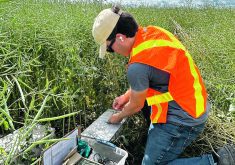The coloured maps depicting cellular service across the Prairies don’t paint an accurate picture. The dead spots are conspicuous by their absence.
Even the Trans-Canada Highway is pocked with no signal pits.
Many developing nations have better cell coverage at a lower cost, according to Manitoba farmer and entrepreneur Jeff Penner, who spent time in Liberia last summer delivering a V-Wing land scraper.
Penner has suggested that Canadian prairie farmers might be willing to donate five-acre plots of land on prime strategic hilltops if cell service providers would erect towers.
Read Also

Agritechnica Day 2: The future of tractor power, building quicker crop apps and large farms and tech
Agritechnica Day 2: The future of tractor power, building quicker crop apps with Syngenta and large farms and tech
Other stories in this Special Report:
The Western Producer posed this proposition to Bell-MTS, SaskTel and Telus in Alberta. All three companies were asked the same set of six questions.
- Why do rural areas have so many dead cell spots?
- Rural people say the basic “build it and they will come” concept applies. There are numerous economic and educational opportunities they would access if they could. The demand cannot express itself until the service is in place. Can you comment?
- The public owns the airwaves. Doesn’t the corporate sector have a responsibility in terms of providing better police/ambulance/fire service to people in rural areas?
- Some farmers are willing to donate five-acre plots of land in key strategic locations for towers, boosters or repeaters for improved service. Is that enough to get the ball rolling?
- Is your company aware that Canadian commitments through the Paris Accord require farmers to employ precision agriculture technology that depends on reliable accurate cellular communications?
- Is there a plan to expand coverage to agricultural areas that are under-served or not served at all? Exactly where is that expansion targeted?
Bell MTS and Telus in Alberta would not consent to a phone interview, and would answer only with prepared statements via email. SaskTel participated in a telephone interview.
Rural demands
The Saskatchewan Association of Rural Municipalities passed the following resolution in 2016.
WHEREAS cell phone coverage and internet access in rural Saskatchewan are nonexistent or unreliable at best; and
WHEREAS municipalities all over the province are losing business because of poor coverage; and
WHEREAS businesses and individuals in Canada are losing revenues because they are having to pay U.S. roaming charges;
BE IT RESOLVED that SARM lobby the provincial and federal governments to improve cellphone and internet service access across Saskatchewan as quickly as possible; and
BE IT FURTHER RESOLVED that these services be available to municipalities and rural residents at a reasonable cost.
SaskTel
Providing 100 percent coverage is a logistical challenge because Sask-atchewan has the lowest number of people per sq. kilometer in Canada, SaskTel spokesperson Greg Jacobs said in a phone interview.
“We do cover 99 percent of the population in the province, but that last one percent is the almost uncoverable one percent,” said Jacobs, adding that people in those locations may need to resort to satellite phones to get reliable coverage.
“The significant investment in putting up new towers requires a guaranteed return on investment,” said Jacobs. But SaskTel has a partial loophole to manoeuvre around this financial obstacle, called the Community Participation Program.
“We use this program to overcome that (return on investment) issue and provide service to areas where people feel they don’t have the level of service they want. We do an economic model to determine what it will cost us to bring the desired level of service and what we will recoup from our investment.
“Then we calculate what the economic shortfall will be, and we bring this dollar figure back to the community to see if they can cover the shortfall. This way, the people wanting the service have some skin in the game.”
In Saskatchewan, the networks that serve emergency responders are managed by the provincial government, not by SaskTel. He says it’s not the best idea to depend on wireless cell service for emergency communications because no company can guarantee that cellular wireless service is 100 percent reliable. Even with the best equipment, there are many factors that can negatively affect wireless service.
On the topic of donated hilltops, Jacobs says land is a significant factor in establishing new tower sites. However, the cost of bringing infrastructure to a new location are generally greater than the cost of land.
“Land costs do factor into the equation, however they are not the bulk of the investment. In our Community Participation Program, donated land might be one of the items that make up the shortfall. But the equation varies a lot from one tower to the next, so we would need a specific proposal before we could say any more.”
The Paris Accord will see producers increase their use of precision agriculture technology. While SaskTel says they applaud the deployment of any new technologies that will mitigate the effects of climate change, they say this solution is only one of many methods being investigated by the federal government.
“SaskTel owns and operates the largest wireless network in the province; reaching 99 percent of Saskatchewan residents. Given the extensive coverage already in place, it should come as no surprise that we have seen large increases in the demand for wireless data over the past number of years. In re-sponse to this trend, our current priority is enhancing the capacity of our network rather than expanding its coverage.”
Bell MTS
The spokesperson for Bell MTS Jeremy Swatzky replied via email.
“Finding an ideal plot of land is a valuable part of the equation when it comes to building a cellular tower and we’re always happy to talk to people who have these types of ideas or suggestions. However, there are a variety of factors that go into choosing the location beyond its physical address.
Any farmers who have land that they’d like to discuss with us should definitely reach out and we’d be happy to explore options.
“Bell MTS has begun our five-year, one billion dollar investment plan to bring customers across the province faster networks and improved communications services in urban, rural and remote areas alike. We understand the importance of broad availability and reliability of communications services and note that Bell MTS wireless coverage already reaches 97 percent of Manitoba’s population.
“However, as is the case for all cellular providers, the costs associated with network expansion in some rural and remote areas are significant and cannot be supported by Bell MTS alone. If we can’t make a business case for investment in certain areas, then the solutions require partners. We have experience with various funding models throughout the country and are happy to explore funding partnerships with government, communities and other organizations to enhance wireless and broadband service.
Swatzky says Bell MTS has announced plans for the expansion of mobile and wireline broadband networks in northern Manitoba, including along Highway 6 to Thompson, in Flin Flon and in five small indigenous communities. In the south, they have announced plans to ensure continuous broadband wireless coverage along Highway 75 from Winnipeg to the United States border at Emerson.
On a broader scale, they are in the process of expanding and upgrading our province-wide wireless LTE network to LTE-Advanced, which will double current wireless data speeds. They are on track to have about 90 percent of the network upgrade to be completed by the end of 2017.
Telus Alberta
Telus spokesperson Douglas Self responded with the following statement:
“Telus already covers 99 percent of the population in Alberta, and this year we announced we are investing $4.2 billion across Alberta through 2020. We expanded our coverage in Manitoba. Telus now has the province’s largest 4G LTE network, covering 97 percent of Manitobans.
“In some very remote areas it’s incredibly challenging to provide wireless coverage due to the topography of the land and lack of power sources. Enhancing coverage to cover more Canadians is a challenge that the entire telecommunications industry is tackling.
“Before the end of the year, Telus will have invested more than $150 billion in capital and operations to build and support network infrastructure across Canada since 2000.















